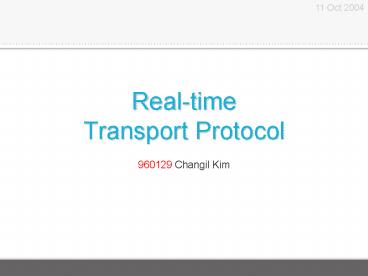Realtime Transport Protocol - PowerPoint PPT Presentation
1 / 12
Title:
Realtime Transport Protocol
Description:
Unreliable, no error recovery, no flow/congestion control ... Media Chunk. 4. Protocol Stack. Transport Layer or Application Layer ? It can be viewed as either ... – PowerPoint PPT presentation
Number of Views:137
Avg rating:3.0/5.0
Title: Realtime Transport Protocol
1
Real-timeTransport Protocol
11 Oct 2004
- 960129 Changil Kim
2
Overview
- Real-time Transport Protocol
- RFC 1889
- Transporting various formats for audio/video
- Carry data that has real-time properties
- Sequence number, timestamp
- Unreliable, no error recovery, no flow/congestion
control - Neither timely delivery nor other
quality-of-service guarantees - Why is it called a real-time protocol?
- It does not ensure real-time delivery, but
- It provides functionality suited for carrying
real-time content
3
Protocol Stack
- RTP Protocol Stack
- Runs on the top of UDP
- RTP Header
- Encoding type, sequence number, timestamp
- Normally 12 bytes
Application
Media Chunk
Media Chunk
RTP
RTP Packet
RTP Packet
UDP
UDP Segment
UDP Segment
IP
IP Datagram
IP Datagram
Data Link
Frame
Frame
Physical
1-PDU
1-PDU
4
Protocol Stack
- Transport Layer or Application Layer
? - It can be viewed as either
Application
Application
Application Layer
RTP
RTP
Transport Layer
UDP
UDP
IP
IP
Data Link
Data Link
Physical
Physical
5
Protocol Stack
- As a transport protocol
- It runs on end systems
- It provides demultiplexing
Application
RTP
Transport Layer
UDP
IP
Data Link
Physical
6
Protocol Stack
- As an application protocol
- It is mostly implemented within applications
- It passes RTP packets to the UDP socket
Application
Application Layer
RTP
Socket
UDP
IP
Data Link
Physical
7
Packet Header Fields
- Packet Header 12 bytes
Sequence number
Payload Type
Miscellaneous
Timestamp
Synchronization source identifier (SSRC)
8
Packet Header Fields
- Packet Header 12 bytes
- Payload Type
- 7 bits
- Indicate the type of audio/video encoding
Sequence number
Payload Type
Miscellaneous
Timestamp
Synchronization source identifier (SSRC)
9
Packet Header Fields
- Packet Header 12 bytes
- Sequence number
- 16 bits
- Used to detect packet loss and to restore packet
sequence - Increase by one for each RTP packet transmitted
Sequence number
Payload Type
Miscellaneous
Timestamp
Synchronization source identifier (SSRC)
10
Packet Header Fields
- Packet Header 12 bytes
- Timestamp
- 32 bits
- Used to place the incoming packets in the correct
timing order - Remove jitter and provide synchronous playout
- Increase by the time covered by a packet
Sequence number
Payload Type
Miscellaneous
Timestamp
Synchronization source identifier (SSRC)
11
Packet Header Fields
- Packet Header 12 bytes
- Synchronization source identifier (SSRC)
- 32 bits
- Identify the source of the RTP stream
- Each stream in an RTP session can have a distinct
SSRC
Sequence number
Payload Type
Miscellaneous
Timestamp
Synchronization source identifier (SSRC)
12
Thank You

